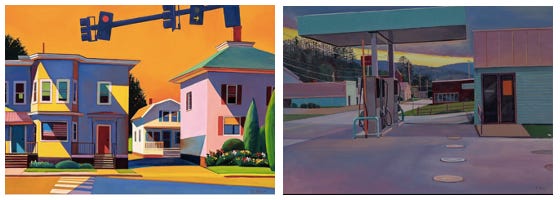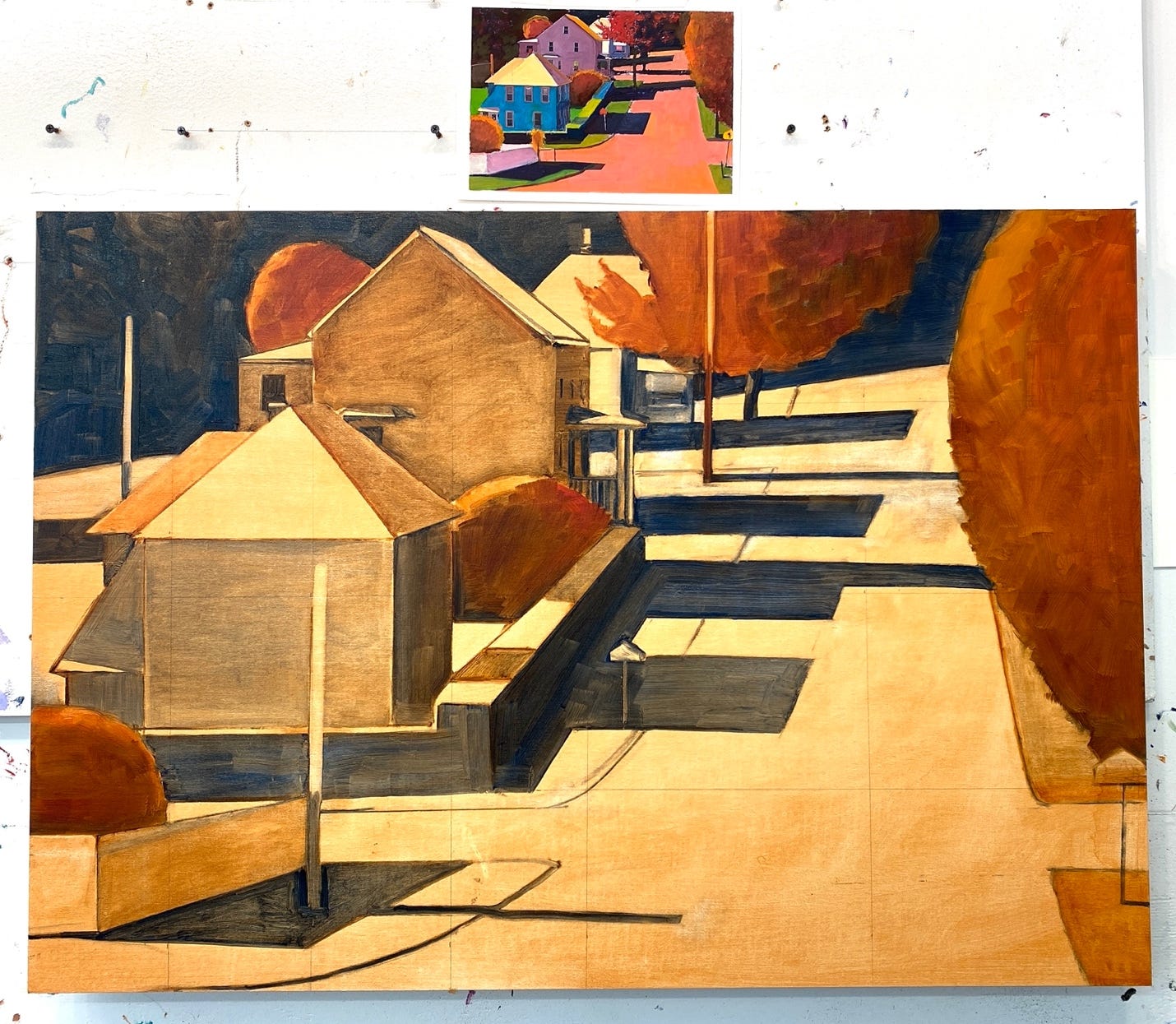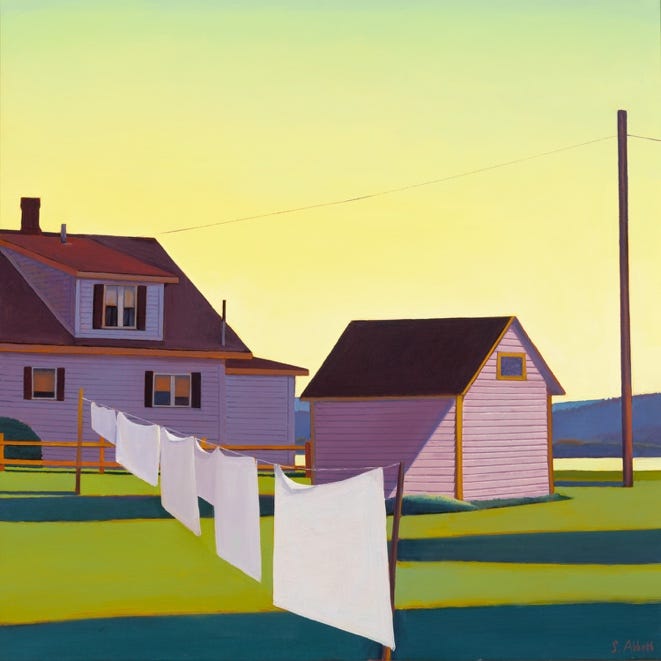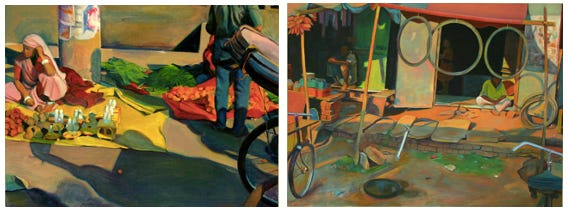Susan Abbott, painter
What led to a dramatic shift in her work, a happy accident with a borrowed camera, and her admiration for awkwardness
Susan Abbott’s paintings of New England landscapes and scenes from her travels to locales such as Malaysia, India, Provence, and Spain capture a sense of place and an exuberant playfulness with color.
Susan’s art career started in Maryland where she grew up and went to art school. For the first 15 years of her professional life, she painted highly detailed watercolor still life, overhead views of tabletops that tell a story with bowls of fruit, mysterious envelopes, photographs, patterned fabrics, and evocative objects and keepsakes.
Despite Susan’s early success as an artist based in the urban centers of Washington, DC, and New York, the pull of living in a rural and natural environment ultimately led to her to move to Vermont. Lucky for us, the move also led her to an artistic shift toward oil landscapes and figure painting. Through it all, Susan has been teaching art, traveling with a sketchbook, and drawing on an art lineage that includes Jean-Baptiste-Camille Corot, Piero della Francesca, and Richard Diebenkorn. Here’s our recent conversation.
Tell me about your upbringing.
My father’s parents immigrated from Syria and he was the first child to go to college. He did the very impractical thing of studying painting at Cornell University and then was a union organizer during the Depression. He became a commercial artist to support our family and I spent quite a bit of time as a young person helping out in his design studio.
Like many kids growing up in the 1950’s and 60’s I had a lot of unstructured time and was outdoors playing in the creeks and woods around our house or indoors making things out of my imagination.
Painting was always in the background, as my father’s paintings were hanging throughout our home, and there were art books and art supplies around. My mother worked with her hands, too—cooking, knitting, and sewing, and she taught me to do all of those.
When did you decide you wanted to pursue art seriously?
I dropped out of high school, which my parents were not happy about. But a big suburban high school wasn’t where I wanted to be, so I ended up in a tiny school for misfits for a few months of coursework and was able to get my diploma a year early. When I was 16, my father found a summer figure-drawing class at American University for me and that was life-changing. I went in sketching tiny, hesitant pencil drawings and came out a few months later modelling big bold figures in graphite. By then I knew I wanted to go to art school.
At the time there wasn’t much training available for students who wanted to work in a realist tradition, which is what I was interested in. It was the height of conceptual art and abstraction. I got on a train and travelled across the country looking at art schools in San Francisco and Chicago but eventually ended up an hour from home in Baltimore at the Maryland Institute College of Art because it had the best painting program. I studied with a wide range of “perceptual” painters including Israel Hershberg, then stayed on at MICA for graduate school in a program run by abstract painting icon Grace Hartigan.
When did you start selling art?
In college I sold a painting occasionally, and my mother would buy my paintings for a couple hundred dollars each when I was broke and needed art supplies. My father also helped me in those early years by passing on calligraphy and illustration jobs. Other than a one-week stint as a waitress, the only way I've ever made an income has been through making and teaching visual art.
You went on to create watercolor still life that were very successful.
In the years after graduate school, I developed a style of tabletop still life that integrated objects, pattern, text, and landscape and figure imagery. I hadn’t formally studied watercolor, but when I was growing up my father had taught me the basics. The reason watercolor became my main medium had a lot to do with becoming a single parent in my late 20’s. My life became very busy with taking care of my son, starting to teach art, doing illustration jobs to support us, and trying to establish a painting practice.
Unlike oils which need more of a flow, you can pick up and put down watercolor for short bursts of time. The watercolor still life in this Dream Table series were large and labor intensive, but I could work on them in sections for a half-hour if that’s all the time I had or, with the help of childcare, for a full day. They sold very well in galleries in DC and New York City, and I also had many still life commissions, including one for Oprah Winfrey that she featured on her show. I felt as though the compositional approach and imagery were really my own and very much enjoyed creating them—until I didn’t!
You moved from Maryland to Vermont after you were an established painter. Describe that transition and how it changed your art.
By this time, I had remarried and had a second son. My husband and I had grown dissatisfied with living in the Washington area and both of us had a love of country things, so we made a move to rural Vermont. It also seemed like a good place to raise our second son, who at four loved being outdoors. (That four-year-old is now a documentary filmmaker with a specialty in wilderness exploration.)
It was an impractical move spurred by just falling in love with Vermont—how it looked, how people lived up here. Getting ourselves up here took about five years, from the first crazy idea to loading up our moving van. My husband was a federal prosecutor in DC and relocating basically meant starting over in his career—and that in some ways was true for me, too.
In the beginning I was still spending long hours each day at my drafting table working on still life, but before long I became unhappy with that and was feeling a pull back to landscape and oil painting. It was a gradual transition, helped by having both my DC and NYC gallery close—that eliminated the pressure to keep them supplied with the watercolor still life paintings that had sold well for us.
I “retrained” in oil painting by creating 6” x 6” panels of a landscape or still life every day. I sold them online to my mailing list, which provided income while I made a change to something new. It was an uncertain process for a couple of years, but exciting.
Tell me about your current process for creating a painting.
I do fast sketches for ideas and take a lot of photos around where I live or when traveling, and then winnow hundreds down to one that has a composition that grabs me. I’ll shoot the photos out of a car window or on a walk down a dirt road near my studio, or around a neighborhood in a nearby town that I think has possibilities for compositions. Once I choose a photo, I desaturate it in Photoshop so that I'm working from a black-and-white reference. I’ll also use a digital drawing program to remove shapes in the photo that don’t add to my idea. Then I'll invent the color for the painting based on design, mood, and the specifics of the place.
I often do an underpainting on the canvas, usually in burnt sienna and ultramarine blue. That establishes the drawing and the values. After that dries, I'll start adding the colors I’ve decided on. I wasn’t trained as an abstract painter who works things out on the canvas. I need to have that armature of my drawing, the values, and the color worked out ahead of time. But the painting never goes where I think it’s headed, there are a lot of surprises along the way.
How do you choose the colors—do you establish the palette before you begin painting?
I determine color in a couple of ways. I'll do painted swatches that help me think about the color composition. Sometimes I paint right on the black-and-white photo. I’ll also experiment with color composition using Markup, a simple digital program. Once I'm painting, I do a lot of adjusting. I'm tweaking color right up until the end.
Finishing a painting is my least favorite part, how detailed I want to get, knowing when to stop. I always have three or four paintings going at a time, which gives me a welcome delay on having to make those final decisions!
There's a painting of yours, Walking Up from the River, that I really like. When you shared it on Instagram, you wrote, “sometimes a painting is a signpost for where you want your work to go and this one was for me.” Explain.
I think that occasionally artists make a painting where we manage to do something new, and that becomes a guidepost for where we want to head. In Walking Up from the River, the combination of a sense of a specific place (that’s a street in Middlebury, Vermont) with the abstraction of geometric shapes and heightened color really appealed to me. I struggle in each painting with finding an equilibrium between a compelling abstract design and communicating the emotion I feel for an actual place I’ve experienced.
Tell me about your family series paintings, such as The Four Generations in Late Summer.
I’ve always loved figure painting, studying it in school and later including figure images in the tabletop still life. More recently I’ve been thinking about the theme of the figure integrated into a landscape, a subject that goes way back to Poussin and Corot and continues up through Bay Area figurative painters like Elmer Bischoff and Richard Diebenkorn.
What sparked this current series was a photo album my husband found when cleaning out a closet. It was full of 3” x 3” fuzzy black and white photos of generations of his family standing in their yards or posing on vacations. My husband’s dad grew up in a western Pennsylvania mining town and his mom was from a wealthy Philadelphia suburb, so the landscapes were different for the two parts of the family. I don’t know many of the people shown other than from my husband’s stories, so to me the images are quite mysterious and evocative.
I began by doing watercolor studies and then oil paintings based on the photos. I invent the color and alter the landscape to make a stronger design. I’m also finding some new interesting “figure in landscape” references by digging around on the internet. I’m really enjoying the challenge and the chance for storytelling this subject offers. I’m looking forward to doing more.
Tell me about your experience of walking the Camino de Santiago, a 550 mile pilgrimage route beginning in France and ending at Cathedral of Santiago de Compostela in Galicia in the northwest of Spain.
That very long walk was the most fun I've had in my life. I hiked 10 to 20 miles a day for two months, traveling very light with just a change of clothes, sketchbook, and watercolor supplies. Walking alone across Spain, through all kinds of places from cities to forests to remote villages, sharpened my senses and quieted my mind. I stopped and painted a small watercolor when a view grabbed me and drew in my sketchbook when I rested in a café or at the end of the day in my hostel bunk.
I had the idea while walking to make a series of oil paintings that describe the changing landscape I witnessed as a pilgrim on the Camino. When I returned to Vermont, I spent the next year in my studio painting 25 landscapes of views across Spain, each showing the changing path of the Camino. I’m delighted that I’ll be having a museum show and producing a catalogue of my An Artist’s Pilgrimage series this fall.
Tell me about your Wonder Road paintings from your time in India. I understand that not having a properly functioning camera resulted in a happy accident.
I went to India for three weeks to teach a sketchbook and watercolor workshop. We toured around Rajasthan and I painted watercolors, filled sketchbooks, and shot a lot of photos—many of them out of our moving van as we traveled through crowded villages and down quiet rural roads. I loved India. I was just blown away by how industrious the people were, how interesting everything looked, the vividness of the colors, and how unexpected everything was.
This was before iPhones, and I had borrowed my son’s digital camera before the trip as mine had broken. I didn’t know it, but the camera had a substantial lag—I'd snap a picture, and it would capture the image three seconds later. I came home and looked at them, and found that most of my photos were not what I had thought I was shooting.
Instead, they all had a slightly chaotic feeling of everything moving out of the frame, very immediate and random. There would be a rickshaw and a person walking off the edge, and then in the middle something I wasn't even expecting to see.
For the next year, in my studio I worked on 25 paintings, a series I called Wonder Road, basing the compositions on the photos I’d shot, with my usual heavy edits and invented color.
I found that the camera lag I’d experienced in India permanently influenced my sense of composition. What I have become interested in painting is not so much the “stuff,” the subject, but the spaces between things, and what’s happening at the edges. The unexpected.
Can you talk about your blog post, In Praise of Awkward Painting?
I think we often admire what we aren't. I like to be in control in general, and with a painting want to know where I'm going, yet when I look at other people's work, I’m most drawn to a more intuitive, awkward, and messy kind of art.
I think it’s healthy to be attracted to what I’m not, because it keeps me in a state of some uncertainty and tension about my work, which helps me avoid becoming over-certain about my painting process. I like control, sometimes more than I should—so even letting one area of a painting be less developed than another, or not adding that last layer of detail when I don’t really need it, can feel like a small victory.
Have you created a painting of yours that you don't want to sell?
I kind of wish I hadn't sold Walking Up from the River, but I don’t hold on to my studio work. When I finish a painting, I’m ready to let it go.
I have two of my Dream Table watercolors up in my home though. I bought one back when it went on the resale market, a 40” x 60” in our bedroom and I'm happy to have that around as it’s one of those “marker” paintings, in this case the first really big watercolor I made. The other watercolor still life hangs in my dining room and brings back happy memories of a trip I took with friends to Italy.
What would you say is the best or worst advice that you received about being an artist?
A teacher who I really respected wasn't happy with where I was going with my work and said, “There is heaven on one side and hell on the other, and you're walking a very fine line between the two.” I ended up going in the direction he thought was hell. I myself as a teacher wouldn’t be that certain with a student about the wrongness of where she was taking her work because I think that we each need to find our own path. It’s very difficult to develop your own voice as an artist, and if you pay attention too much to others’ opinions on where you’re going with your art, you lose your way.
Tell me about teaching art.
I teach workshops, short painting courses either onsite or online. When I travel to teach, I go to places that I’d like to explore myself, trips coming up are Santa Fe, Maine, and Italy, and also plein air workshops at my Vermont studio. I've come to see teaching as a way I can give something back after the wonderful work I’ve been lucky enough to pursue, and as a way I can pass on my love of long-gone painters that have inspired me and who I learned about from my own teachers. Plus, my usual work life is very solitary, so I enjoy being with students as a break from that.
I teach color and design concepts rather than how I myself paint, with a big emphasis on learning from the best in art history. For example, I recently taught a class on Matisse, where we did a deep dive into his biography and then exercises that pulled lessons out of his approaches to color and design.
The only class I teach for beginners is Traveling with Your Sketchbook, which is usually an online class. It's a crash course in getting comfortable drawing and painting quickly. It emphasizes that the experience of drawing rather than the product is what’s most important. [Susan talks about traveling with a sketchbook here.]
Lightning round questions
What art is in your bathroom? Two landscapes of vineyards I painted in Provence.
Most memorable meal. Dinner at my Syrian grandmother’s home in Ithaca, New York, when we would visit on summer vacation. The whole family would gather for a feast of her homegrown baby kousa squash stuffed with saffron rice and lamb, grilled kibbeh balls filled with bass that my uncle had caught in Cayuga Lake, tabbouleh (heavy on the parsley not the wheat!), homemade pita with herbed laban, and pistachio baklava. The memory of Immay’s cooking has completely spoiled my taste for anything I order in a Middle Eastern restaurant.
You're hosting a dinner party for six people living or dead. Who are you inviting and what are you serving? My husband's father, who I unfortunately never met. He began life as a coalminer and went on to earn an MFA from Columbia and become a university vice-president. Henri Matisse and Richard Diebenkorn, because both are favorite painters of mine and Diebenkorn worshipped Matisse. Two Victorian novelists that I read over and over: Anthony Trollope and George Eliot, and contemporary painter Lois Dodd for the fun of seeing how she’d react to everyone.
I'm a gardener and like many Vermonters grow as much of our food as I can. I would ask my husband to make his lemon garlic roast chicken (we’d squeeze him in for dinner, too) using a big chicken from our freezer that we raised. I’d serve spring vegetables and fruit from our garden: cream of sorrel soup as a starter, then roast fingerling potatoes with rosemary, a salad of baby greens with lemon vinaigrette, and for wine, a dry Provençal Rosé. For dessert, chocolate ganache with raspberry sauce [Count me in].
Favorite piece of art that you own. A painting that my older son made in art school.
Most captivating museum visit. The Corot rooms in the Louvre.
Palate & Palette menu
If Susan and her husband came to dinner, which they are invited to do, I would serve tapas:
Garlic shrimp
Patatas bravas
Warm kale salad with almonds and Serrano ham
Vegetable tortilla
Fried eggplant with honey
Rustic apple tart
Where to find Susan Abbott (and you should!)
Sign up for exhibit and workshop newsletter
Gallery at Somes Sound, 1112 Main St, Somesville, Maine
Edgewater Gallery, 1 Mill St., Middlebury, Vermont
Horizon Gallery, 30 S. King St., Jackson, Wyoming





















I always enjoy learning about other artists' approaches to their work, so I found the interview with Susan Abbott to be very interesting. Even though my own approach to painting may be different from hers, I still found it valuable to gain insights into her creative process. I love her subject matter and choice of colors. Thank you Amy for bringing forth such diversity.
Liked this article and enjoyed the examples of Susan’s work. Impressed that she did the Camino. Something I’d like to do for sure.